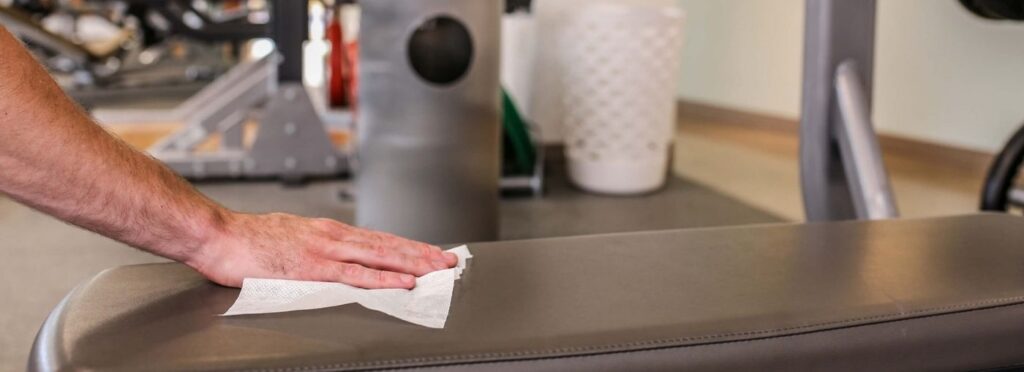03 Aug Know the difference between sanitizing and disinfecting to keep your gym clean and profitable

Even with COVID mostly behind us, everyone from your staff to your members are thinking about cleanliness. All this additional focus on cleaning means you need to get it right. If you get it right, there’s ways to then leverage that to really boost your bottom line.
Keep your gym highly profitable by cleaning it efficiently yet properly, and then make your cleaning procedures extremely visible so your current and prospective members trust your gym is a clean and safe place to improve their health and wellbeing, which is their ultimate goal.
Not All Cleaning Products Are Made Equally
The first step in this process is to purchase and use cleaning products properly. With so many options out there, the different choices can be confusing. To make matters worse, there are shady companies out there that want to make you believe they’re selling you high-quality products when in fact nothing can be further from the truth. Protect yourself and your bottom line by knowing what’s a quality cleaning product and what’s not.
Sanitizing And Disinfecting Are Two Different Things
Contrary to popular belief, sanitizing and disinfecting are two different things. They are highly regulated terms that only federally registered products can claim.
Adding to the confusion, in the United States, “sanitizing” is a term used in two very different ways and regulated by two separate federal agencies.
Sanitizers for hands and the body. These are regulated by the FDA (Food and Drug Administration). You can easily identify a skin sanitizing product by locating its “Drug Facts” panel on its packaging, and it usually has the word “sanitizing” on the front of the packaging somewhere.
Sanitizers for hard surfaces. These are regulated by the EPA (Environmental Protection Agency), which defines sanitizers as an agent “used to reduce, but necessarily eliminate, microorganisms from the inanimate environment to levels considered safe as determined by public health codes or regulations”. Sanitizers are typically used in food service but not in places where more robust cleaning in required, such as a gym or hospital. The 30 second to 1 minute sanitizing claim is typically only against a couple of bacteria. It does not apply to viruses like COVID and the flu, or to fungi such as athlete’s foot.
Disinfecting. In the United States, “disinfecting” is a term that’s regulated by the EPA. You can easily identify a disinfectant by locating it’s “Active Ingredients” information on its packaging as well as it’s EPA Registration Number and EPA Establishment Number. It also usually has the word “disinfecting” on the packaging somewhere.
If a product fails to present the required EPA or FDA information, it has not been tested or approved to kill germs. Even worse, some products make themselves look like they are “sanitizing” or “disinfecting” but in reality they are just a cleaning product that doesn’t kill any microbes. As long as you look for the proper registration information you’ll ensure you’re using products that actually kill germs as intended.
Disinfectants Are Stronger Than Sanitizers
Since sanitizers and disinfectants have two different use cases and are regulated by two different agencies, they have much different standards they are required to meet.
Hand and body sanitizing wipes should not be used to disinfect inanimate surfaces. They have a much lower bar to pass to get approval from the FDA. Essentially, they aim to have a 3 Log10 reduction in germs – which means if you start with 1,000,000 germs you can still have 1,000 germs left after sanitizing and still gain approval. Additionally, there are currently no sanitizing-only products with approved virus claims, so they’re not guaranteed to kill things like HIV, SARS or Swine Flu.
Disinfectants have a much more difficult bar to pass to get approval from the EPA. A disinfectant must destroy or irreversibly inactivate bacteria, fungi and viruses. They must show at least a 5 Log10 against bacteria, which is much more difficult than the sanitizer test. To put this in perspective, it takes most products and companies about a year to conduct all the necessary tests to submit to the EPA for approval. Disinfectants can also be tested against specific strains and therefore make specific claims on what specific germs they kill. This is especially important for gyms, which must be actively fighting against MRSA any chance they can get. For your gym, choose disinfectants that claim to kill MRSA specifically, which should be listed on their label.
Sanitize Hands, Disinfect Surfaces
Identifying the difference between cleaning products is the first step to procuring good cleaning products. The next step is to ensure you’re using them properly. The general rule of thumb to keep your gym safe and clean is to “sanitize hands and disinfect surfaces”.
To keep your members’ hands clean, you should provide them with hand sanitizer – gel is preferred. To kill microbes on the surfaces of your gym equipment, you need to use a disinfectant such as disinfecting gym wipes or a disinfectant spray.
Fitness Business Podcast Recommends Vapor Fresh Disinfecting Gym Wipes
Vapor Fresh is a preferred partner of FBP. Vapor Fresh has a line of EPA registered disinfecting gym wipes that uses citric acid to disinfect instead of the harsh chemicals found in other gym wipes that have known skin, eye, lung and reproductive health concerns. Vapor Fresh Disinfecting Gym Wipes are trusted by some of the most premier gyms and college recreation centers nationwide. Keep your members and staff safe with Vapor Fresh’s greener chemistry!
Vapor Fresh has small disinfecting wipe canisters perfect for home gyms and small studios, as well as large disinfecting wipe refill rolls that fit in all wipe dispensers for larger gyms and fitness centers.

Stephen Steinberg
Stephen Steinberg founded Raw Athletics, the company behind Vapor Fresh, back in 2008 for one reason- to develop stronger and safer cleaning products that could keep up with an active lifestyle.


